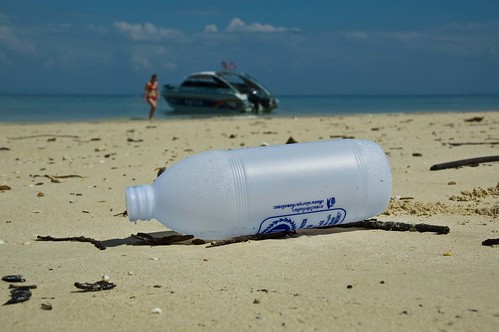
Last week we blogged about a UNEP report with some scary statistics about the colossal amount of plastic rotting in our oceans, as well as the lack of studies on its biological impact. Well, a report given recently at a meeting of the American Chemical Society is cautioning us that these soggy plastics are already releasing carcinogens (cancer-causing substances) as well as compounds that meddle with reproductive hormones as they decay in our oceans.
This report directly contradicts previous assumptions that plastic remains fairly stable in the ocean, suggesting instead that many common plastics like polystyrene begin to decompose within just one year, leaving a variety of nefarious new styrenes to worm their way into the food chain. The worst of these have been shown to effect animal reproduction and cause cancer. Lead researcher Dr. Katsuhiko Saido has commented that this is “giving rise to yet another source of global contamination that will continue into the future.” This is especially worrying because the amount of plastic in our oceans is only growing.
Feel compelled to get involved? The Marine Conservation Society’s Annual Beachwatch event is the 19th and 20th of September—visit their site to find out how you can volunteer to help monitor marine litter and clean beaches in the UK.
This report directly contradicts previous assumptions that plastic remains fairly stable in the ocean, suggesting instead that many common plastics like polystyrene begin to decompose within just one year, leaving a variety of nefarious new styrenes to worm their way into the food chain. The worst of these have been shown to effect animal reproduction and cause cancer. Lead researcher Dr. Katsuhiko Saido has commented that this is “giving rise to yet another source of global contamination that will continue into the future.” This is especially worrying because the amount of plastic in our oceans is only growing.
Feel compelled to get involved? The Marine Conservation Society’s Annual Beachwatch event is the 19th and 20th of September—visit their site to find out how you can volunteer to help monitor marine litter and clean beaches in the UK.
Image: René Ehrhardt - Flickr





2 comments:
Do they decompose in the same way in fresh water? I'm wondering what the implications are for human health if plastics are leaching all sorts of chemicals into our drinking water...
The actual quote on the contributing environmental conditions was: “We found that plastic in the ocean actually decomposes as it is exposed to the rain and sun and other environmental conditions."
Saltwater versus freshwater could presumably have differential effects, but that remains unspecified. This is only the first study that even approached the problem of analyzing aquatic breakdown of plastic. Considering that contributing factors were sun, rain, water and mechanical breakdown, it wouldn't be much of a theoretical leap to assume that the same processes may be at work in bodies of fresh water.
Post a Comment